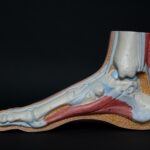Are you ready to delve into the remarkable world of tendon mechanics? Brace yourself for a captivating journey as we uncover the hidden secrets behind the transmission of forces by tendons. In this article, we will unravel the intricate mechanisms that enable these vital connective tissues to transfer forces throughout the body. As we embark on this exploration, prepare to be amazed by the awe-inspiring biomechanics that expertly transfer power, resilience, and strength. So, let’s dive in and unlock the power within the astonishing world of tendon transmission!

Transmission of Forces by Tendons
Tendons, those flexible and inelastic bands of connective tissue, play a crucial role in our musculoskeletal system. They are responsible for transmitting force from our muscles to our bones, allowing us to move and stabilize our bodies. But how exactly do tendons unleash their power in the transmission of forces? Let’s dive deeper into this fascinating mechanism.
At one end, tendons are connected to muscle fibers, while at the other end, they attach to bone components. This connection allows tendons to efficiently transmit forces generated by the muscle to the bone. By doing so, tendons serve to protect our muscles from potential injury during movement. Imagine tendons as strong, resilient bridges, guiding the force from the muscle to the bone, preventing any mishaps along the way.
However, the transmission of forces by tendons is not without its challenges. Strain can sometimes concentrate at the site where the muscle and bone tissues merge, making proper loading and maintenance of tendon health crucial. Tendons are designed for these demands, as they are stiffer and possess greater tensile strength than muscles. They are composed of type-I collagen fibers that align in a parallel fashion, forming a robust structure capable of withstanding substantial forces.
To truly understand the transmission of forces by tendons, we must zoom in on the intricate mechanics involved. The myotendinous junction, where muscle fibers merge with the tendon, and specialized tendon structures both contribute to this phenomenon. Picture the myotendinous junction as an intersection, where the muscles and tendons meet to exchange forces. This junction is reinforced by delicate structures within the tendon, enhancing its ability to transmit muscular strength effectively.
Proper mechanical loading is vital for tendon health and function. Just as regular exercise helps us maintain overall well-being, appropriate loading ensures the optimal function of our tendons. It’s like giving them a workout tailored to their needs. When tendons experience the right amounts and types of forces, they adapt and become stronger over time, effectively supporting and enabling our movements.
Now let’s explore the practical implications of the transmission of forces by tendons. When we engage in activities that require high levels of force, such as weightlifting or sprinting, tendons help us achieve peak performance. They efficiently transfer the power generated by our muscles to our bones and joints, allowing us to generate forceful, controlled movements. Without the transmission of forces by tendons, our ability to produce powerful movements would be severely compromised.
In conclusion, tendons are remarkable structures that contribute to the movement and stability of our bodies. They transmit forces from our muscles to our bones, ensuring efficient and controlled movements. By understanding the intricate mechanics of tendon force transmission, we can unleash the full potential of our bodies. So let’s appreciate and take care of our tendons, for they are the silent superheroes behind our powerful movements and graceful stability.
“Tendons, like resilient bridges, transmit forces from our muscles to our bones, protecting our muscles while enabling powerful movements.”
Tendon Function plays a critical role in our body’s movement and stability. These tough bands of fibrous tissue connect muscles to bones, acting as essential connectors for our skeletal system. Whether you’re an athlete pushing your limits or simply performing daily activities, understanding the intricacies of tendon function is vital for preventing injuries and optimizing performance. Explore more about this fascinating topic at our comprehensive guide: Tendon Function. Discover the mechanics behind tendon movement, the factors influencing tendon health, and practical tips to keep your tendons in top shape. Don’t miss out on this opportunity to delve into the world of tendon function and unlock the secrets to achieving peak physical performance.
FAQ
Question 1
What are tendons and what is their role in the body?
Answer
Tendons are flexible and inelastic bands of strong fibrous connective tissue that transmit force from the muscle to the bone. They are connected to muscle fibers at one end and bone components at the other end. The main role of tendons is to transmit forces from the muscle to the bone and prevent injury to the muscle.
Question 2
How do tendons transmit forces without getting injured?
Answer
Tendons can experience strain concentrated at the site where muscle and bone tissues merge. However, they are stiffer and have greater tensile strength than muscles. This allows tendons to effectively transmit muscle strength to the bones and joints, while also withstanding the forces exerted during movement without getting injured.
Question 3
What are the key structures involved in the mechanical force transmission of tendons?
Answer
The mechanical force transmission of tendons involves the myotendinous junction and specialized tendon structures. These structures ensure the efficient transfer of forces from the muscle to the bone, enabling the body to move and stabilize effectively.
Question 4
What is the composition of tendons?
Answer
Tendons are composed of type-I collagen fibers arranged in a parallel alignment. This arrangement provides tendons with the necessary strength and flexibility to transmit forces and withstand the demands of physical activity.
Question 5
Why is proper mechanical loading important for the health and function of tendons?
Answer
Proper mechanical loading, which involves the appropriate amount and type of physical stress, is crucial for maintaining the health and function of tendons. Adequate loading stimulates tendon adaptations, such as increased collagen synthesis and improved tissue organization, which promote tendon strength, durability, and overall performance in supporting movement and stability in the musculoskeletal system.
- Georgia Platform: A Southern Strategy, 1850s - March 31, 2025
- How many weeks is 40 days: Quick Conversion Guide for Accurate Results - March 31, 2025
- How many feet is 300 meters? 984 Feet: Understand Length Conversions Easily - March 31, 2025
















